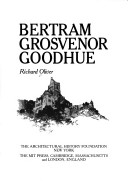Bertram Goodhue was the undisputed eclectic synthesist of his generation in America. His wide repertory included elements from Gothic, Spanish, and Classical styles to create such landmark buildings as St. Thomas's church in New York, the National Academy of Science in Washington, and the Nebraska State Capitol which Henry-Russell Hitchcock called "the most innovative state capitol built in the twentieth century." Goodhue's Church of St. Bartholomew in New York and his Central Library in Los Angeles are currently the focus of heated preservation debates.This book goes beyond the stock characterizations of Goodhue as a derivative architect or protomodernist. It shows Goodhue as a talented exemplar of the free eclectism of the late nineteenth century, an innovator who freshly interpreted traditional forms. The author discusses Goodhue's early career during which he displayed a remarkable skill in draftsmanship and decorative design, as well as his later search for new directions after the impact of Scott's Liverpool Cathedral stimulated him to reevaluate the function of tradition in contemporary practice.The author is a registered architect who practices out of his own firm, Richard Oliver Architects, in New York. He has taught at Columbia University, was Curator of Architecture and Design at the Cooper-Hewitt Museum for several years, and is the author of two previous books, "Architectural Drawing" and "America's Grand Resort Hotels." This is included in the Architectural History Foundation's American Monograph Series.
- ISBN10 0262150247
- ISBN13 9780262150248
- Publish Date 20 July 1983
- Publish Status Out of Print
- Out of Print 28 February 2001
- Publish Country US
- Publisher MIT Press Ltd
- Imprint MIT Press
- Format Hardcover
- Pages 192
- Language English
